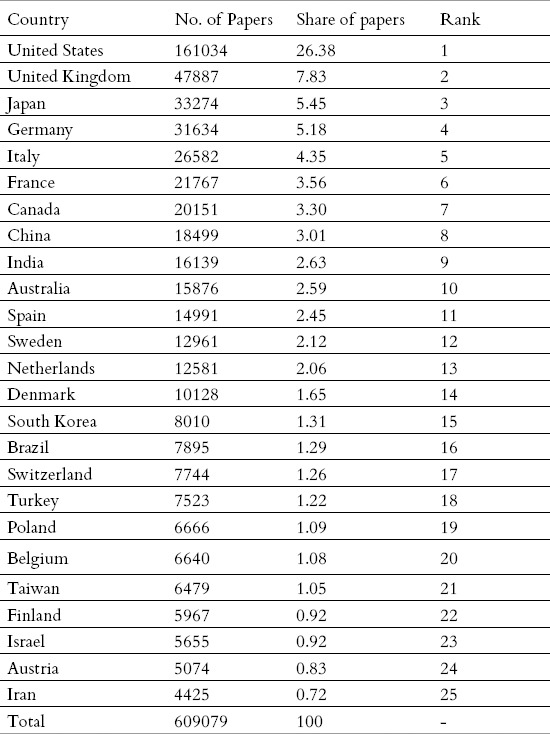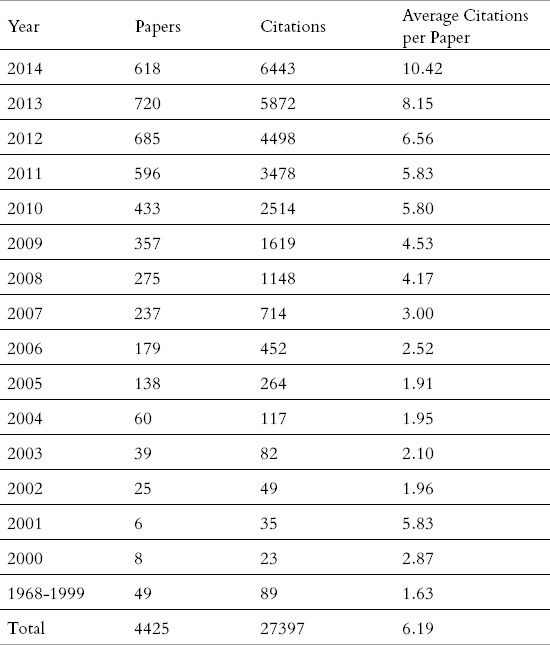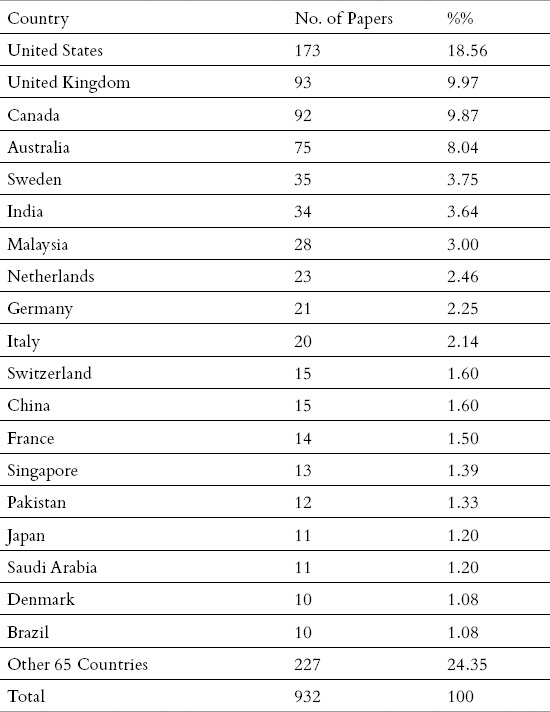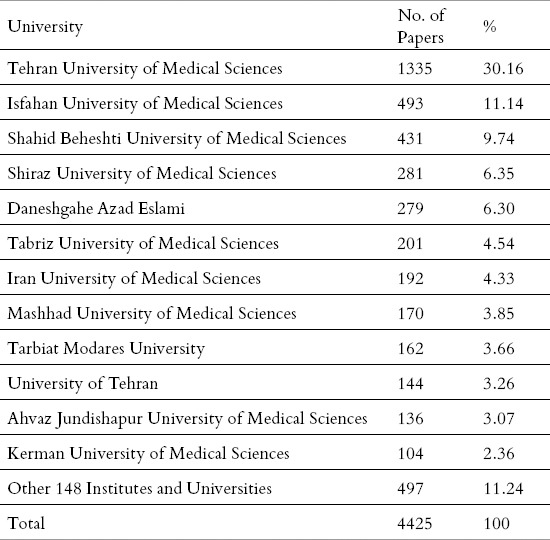Abstract
Introduction:
In the developing countries, diabetes mellitus as a chronic diseases, have replaced infectious diseases as the main causes of morbidity and mortality. International Diabetes Federation (IDF) recently estimates 382 million people have diabetes globally and more than 34.6 million people in the Middle East Region and this number will increase to 67.9 million by 2035. The aim of this study was to analyze Iran’s research performance on diabetes in national and international context.
Methods:
This Scientometric analysis is based on the Iranian publication data in diabetes research retrieved from the Scopus citation database till the end of 2014. The string used to retrieve the data was developed using “diabetes” keyword in title, abstract and keywords, and finally Iran in the affiliation field was our main string.
Results:
Iran’s cumulative publication output in diabetes research consisted of 4425 papers from 1968 to 2014, with an average number of 96.2 papers per year and an annual average growth rate of 25.5%. Iran ranked 25th place with 4425 papers among top 25 countries with a global share of 0.72 %. Average of Iran’s publication output was 6.19 citations per paper. The average citation per paper for Iranian publications in diabetes research increased from 1.63 during 1968-1999 to 10.42 for 2014.
Conclusions:
Although diabetic population of Iran is increasing, number of diabetes research is not remarkable. International Diabetes Federation suggested increased funding for research in diabetes in Iran for cost-effective diabetes prevention and treatment. In addition to universal and comprehensive services for diabetes care and treatment provided by Iranian health care system, Iranian policy makers should invest more on diabetes research.
Keywords: Bibliometrics, Diabetes Mellitus, bibliographic database, Scopus, Iran
1. INTRODUCTION
In the developing countries, diabetes mellitus as a chronic diseases, have replaced infectious diseases as the main causes of morbidity and mortality (1, 2). Diabetes mellitus is a common chronic diseases in both developing and developed world (3). The characteristics of the disease is blood glucose as a result of too little insulin or resistance to insulin (4). Unfortunately its incidence and prevalence are increasing in most populations. The trend is particularly worrying in developing countries (5). Kidney failure result mainly from diabetes; however, its occurrence is associated with its severity and duration and is dissimilar from country to country. Diabetic foot disease often leads to ulceration and limb amputation due to changes in blood vessels and nerves and has major economic consequences for the patients, their families, and society (6). Depression has been found to be more prevalent among people with diabetes than in the general population (7, 8, 9, 10).
In 2010, 70% of people with diabetes lived in the relatively poor countries, and Africa and the Middle East has greatest relative increase in the burden of diabetes mellitus (11, 12). Mortality due to diabetes is more than 80% in the low and middle income countries (13). WHO predicts diabetes will be the 7th most important cause of mortality in 2030 (14) and in 2035 near to 592 million people will die due to diabetes (15).
The complications of diabetes greatly influence the quality of life in patients suffering from diabetes. According to the recent estimates of the International Diabetes Federation (IDF), 382 million people have diabetes globally and more than 34.6 million people in the Middle East and this number will increase to 67.9 million by 2035 (16,17). Prevalence of diabetes is higher in developed counties than in developing and it will raise to 5.4% in 2025 (18).
In Iran, which is located in the Middle East, the prevalence of diabetes mellitus was predicted to reach 8.43% in 2013 and the total health cost for diabetes mellitus was estimated to be roughly 471 million US dollars. In 2013, there were over 4.39 million cases of diabetes in Iran and diabetes related deaths were 38002 cases (18, 19). Diabetes high prevalence among working-age individuals is a threatening sign for this developing country. As the relatively young Iranian population will age in the future and urbanization continues to accelerate; therefore, there will likely be an escalation in the prevalence of diabetes (20).
In a study conducted by Gupta et al, they analyzed the Indian research output in diabetes during 1999-2008 based on different parameters including growth, rank and global publications share, citation impact, overall share of international collaborative papers, and share of major collaborative partners. They also analyzed the characteristics of most productive universities, authors, and highly-cited papers. The publications output, impact and collaborative publication share of India was compared with China, South Korea and Brazil as developing countries (21).
The aim of this study was to analyze Iran research performance on diabetes in national and international context, as reflected in its publications indexed in Scopus database. The following aims also considered: To evaluate the Iranian research output, its growth, rank and world publications share and impact, as well as to study the patterns of international collaboration and major collaborative partners.
2. METHODS
This study was based on the publications of diabetes research from Iranian authors retrieved Dec 31, 2014 from Scopus Citation database [http://www.scopus.com]. The string used to retrieve the data was developed using “diabetes” keyword in title, abstract and keywords and “Iran” in the affiliation field was our main string. We searched above mentioned terms in document search tab of Scopus. The date range was not set for any specific time and we searched all the total documents (4425) indexed in Scopus for Iran from beginning to the end of 2014. We used searching and analyzing features of Scopus. For this purpose data were searched using searching system of Scopus, and then results were analyzed using analyzing result system of Scopus.
To retrieve the data from world diabetes research, the key word ‘diabetes’ was searched in the title, keyword, and abstract fields of the document search tab.
3. RESULTS
Total number of papers for diabetes research indexed in Scopus was 610439 papers until the end of 2014. Top 25 countries with 515582 papers had the most number of papers and a global share of 84.46 %. From top 25 countries with the most number of papers in diabetes research, 20 countries were in the category of developed country including: United States, United Kingdom, Japan, Germany, Italy, France, Canada, Australia, Spain, Sweden, Netherlands, Denmark, South Korea, Switzerland, Poland, Belgium, Finland, Israel, Austria, Taiwan and 5 are developing countries including; China, India, Brazil, Turkey and Iran (Table 1).
Table 1.
World publication output, share and rank of top 25 most productive countries in diabetes research

More than fifty % (52.77%) of the world diabetes research had been conducted by 6 developed countries including: US, UK, Japan, Germany, Italy and France. From top 25 developing countries; China and India ranked 8th and 9th, respectively. Altogether, share of 5 developing countries in the world diabetes research was 8.98% (Table 1).
Iran’s cumulative publication output in diabetes research consisted of 4425 papers during the years 1968 to 2014, with an average number of 96.2 papers per year and an annual average growth rate of 25.5%. In this direction, Iran’s annual growth rate showed minus 14.16 %in the years 2013-2014. The total publications output of Iran in diabetes research increased from 49 papers during 1968-1999 to 4376 papers during 2000-2014 (Table 2). Hence; with 4425 paper, Iran ranked 25th among the top 25 countries with a global share of 0.72 %.
Table 2.
Iranian research papers in diabetes research according to number of papers, citations and average citations per paper by year

Concerning research quality, as measured by field-weighted citation impact, Iran’s publication output as measured by average citation per paper was 6.19 on the whole. So, in diabetes research, Iranian publication average citation per paper increased from 1.81 in the years 1968-1999 to 10.42 in 2014. Overall, the received citations were 27397 citations during those years (Table 2).
In diabetes research, Iran’s collaborated with 84 countries with no more than 932 of its papers (21% of its total papers). In the years 1968 to 2014, among top 19 Iranian international collaborative partners with more than 10 collaborative research papers in diabetes, United States ranked highest in the list by contributing 18.56% of its publications, followed by the following countries: United kingdom (9.97 %), Canada (9.87 %), Australia (8.04 %), Sweden (3.75 %) India (3.64 per cent), Malaysia (3 %) Netherlands (2.46 %), Germany, Italy, Switzerland (between 2.25 to 2.14%), and, China, Singapore, France, Pakistan, Japan, Denmark, Saudi Arabia, and Brazil (between 2.25% to 1.07%). Other 65 countries were Iran’s international collaborative partners with a total share of 227 papers (24.35 %) (Table 3). Altogether, 160 institutes and universities contributed with Iran to produce 4425 papers in diabetic research.
Table 3.
Iranian papers with respect to their international collaborative with different countries in diabetes research

Table 4 shows 12 most productive universities with more than 100 papers in the field of diabetic research. In collaboration with Iran, they produced 3928 papers with a share of 88.76 %. Other 159 institutes and universities produced 497 papers with a collaboration share of 11.23 %.
Table 4.
Contribution and share of top 12 Iranian Universities in diabetes research

Based on publication output of Iran, highly cited papers were also evaluated. In this regard, 170 papers were cited up to 30 times and identified as the papers with the highest citations. From the list, the highest cited paper received 742 citations and ranked 1st.
Regarding the type of Iranian publication being indexed, the most publication type in the field of diabetes research was articles (87.35%), the second most published document was allocated to review articles (5.68%), and the lowest publication documents in the field of diabetes research were books (0.02%).
The 10 authors with 48 or more papers, (in diabetic research in Iran) contributed 972 papers, which accounted for 22 per cent in country’s research output. Among these 10 top authors, three authors have recorded more than 100 papers namely; Larijani, B. (225 papers), Azizi, F. (149 papers), and Amini, M. (108 papers) (Table 5).
Table 5.
Productivity and impact of top 10 Iranian authors in diabetes research

4. DISCUSSION
According to the results of this Scientometric study, Iran had 0.72 % of the total global share in the field of diabetes research. Despite increasing diabetic population in Iran, diabetes research is not sufficient. International Diabetes Federation requested increase in funding for cost-effective diabetes prevention and treatment in Iran (16). Although the Iranian health care system provides universal and comprehensive services for diabetes care and treatment, Iranian government should invest on diabetes research as a way to increase social awareness leading to diabetes prevention.
Among 5 developing countries producing the highest numbers of papers in diabetes research, Iran ranks 5th. Apart from Turkey which has a close population to Iran, population of other 3 developing countries including China, India, and Brazil is 18, 16 and 3 times more respectively. In terms of population, Iran’s papers in diabetic research is considerable; however, more effort should be made.
In 1968, the first Iranian article was published on diabetes research. Later, Iran had no publication in the field of diabetes research for several years (1978-1987). This may be due to the Iran revolution and its involvement in the war with its neighboring country, Iraq. Just in one decade (from 2005 to 2014), out of 4425 Iranian research papers, 4238 papers were published in the field of diabetes, which shows an increasing annual growth in diabetes research in Iran. The total publications output of Iran in diabetes research increased from 49 papers during 1968-1999 to 4376 papers during 2000-2014, showing a 25.5% increase in the Iran’s annual average growth rate in diabetes research. This may be related to the increase in the general Iranian population as well as a substantial increase in diabetes prevalence in Iran (20). Another factor could be increased university’s acceptance rate of Medical Assistant - Endocrine / Metabolism in universities across Iran. Nitrini in his study mentioned to this factor, he believed that the growth in Brazilian publications was due to the development of the post-graduate programs in the country (22).
Gupta et al reported that annual average growth rate of Indian publications in diabetes research during the years 1999-2008 was 13.71 %. they also showed that cumulative publications output of India increased from 1534 to 3290 papers from 1999-2003 to 2004-2008. Compared to India, cumulative publications output of China, Brazil, and South Korea increased from 1436 to 5983 papers, 852 to 2383 papers, and 799 to 2270 papers respectively (21).
Harande and Alhaji examined the growth of published literature on diabetes in three countries of Nigeria, Argentina, and Thailand. The results of their study showed that diabetes literatures grow and spread widely. In the years 1986 and after that, countries in the selected regions witnessed exponential growth in the literature (23).
Previous studies (23, 25) showed that, production of global research papers in the field of diabetes followed a growing trend. The studies concerning diabetes over the last 20 years has been growing (24). Krishnamoorthy et al study showed a significant research activity in the field of diabetes in the world (25). These studies are consistent with our study in which total publications output of Iran in diabetes research increased significantly. This shows that Iran seems to follow this global wave.
During the past decade, there has been an emerging interest in the use of highly cited papers as indicators of research assessment. One of the reasons for this is the increasing focus on scientific excellence in the science policy.” In this context, highly cited papers have been regarded as potential candidates for identifying and monitoring ‘excellent’ scientific research “(26). Collaboration between researchers could be the basis of respect for highly cited research papers. Other studies have shown a general correlation between citation counts and number of authors as well as also international collaboration (27, 28).
Results of this study showed that Iran’s cumulative publication output in diabetes research had been cited 27397 times and Iran is collaborated with 84 other countries in diabetes research with 932 papers (21% of its total papers). In terms of impact and effectiveness results showed that the average citation per paper for Iran’s publications in diabetes research increased from 1.63 in the years 1968-1999 to 10.42 in 2014. The reasons for this increasing rate could be due to Iran’s high international collaboration and Iranian authors’ interest in institutionalization of scientific collaboration. In addition, this increasing rate shows the growing quality of Iranian research papers. Previous studies showed that influential papers receive more citations than other papers of less utility (29, 30).
Among the top 19 Iranian international collaborative partners, by contributing 18.56% of its publications, United States ranks the highest in the list which is similar to the findings of the study conducted by Gupta et al (21).
By producing 1335 papers (30.16%), Tehran University of Medical Sciences has been the most productive university followed by Isfahan University of Medical Sciences and Shahid Beheshti University of Medical Sciences with 493 (11.14%) and 431 (9.74%) papers respectively. These three universities produced more than 50% of Iran’s diabetes research papers. The top 10 Iranian authors in diabetes research are from three mentioned universities.
According to Essential Science Indicators (ESI) Institution Ranking for 2013, the following three Iranian universities are among the world’s top universities and research institutes; in terms of ranking, Tehran University of Medical Science’s ranked 492, Shahid Beheshti University of Medical Science’s ranked 884, and Isfahan University of Medical Sciences ranked 1550.
5. CONCLUSION
Although diabetic population of Iran is increasing, number of diabetes research is not remarkable. International Diabetes Federation suggested increased funding for research in diabetes in Iran for cost-effective diabetes prevention and treatment. Therefore, in addition to universal and comprehensive services for diabetes care and treatment provided by Iranian health care system, Iranian policy makers should invest more on diabetes research.
Acknowledgements
The authors are thankful to Vice Chancellor for Research, Kurdistan University of Medical Sciences to provide access to Scopus database.
Footnotes
CONFLICT OF INTERESTS: NONE DECLARED.
Authors’ contributions
Study concept and design: Masoud Rasolabadi, Shahnaz Khaledi,Marlin Ardalan. Acquisition of data: Masoud Rasolabadi, Susan Penjvini, Alireza Gharib. Analysie and interpretation of data: Masoud Rasolabadi, Alireza Gharib, Marya Maryam Kalhor. Drafting of the manuscript: Masoud Rasolabadi, Shahnaz Khaledi,Marlin Ardalan, Marya Maryam Kalhor, Critical revision of the manuscript for important intellectual content: Masoud Rasolabadi, Alireza Gharib, Susan Penjvini. Study supervision: Masoud Rasolabadi, Shahnaz Khaledi,Marlin Ardalan, Alireza Gharib.
REFERENCES
- 1.Epping-Jordan JE, Galea G, Tukuitonga C, Beaglehole R. Preventing chronic diseases: taking stepwise action. The Lancet. 2005;366(9497):1667–1671. doi: 10.1016/S0140-6736(05)67342-4. doi:10.1016/S0140-6736(05)67342-4. [DOI] [PubMed] [Google Scholar]
- 2.Strong K, Mathers C, Leeder S, Beaglehole R. Preventing chronic diseases: how many lives can we save?The Lancet. 2005;366(9496):1578–1582. doi: 10.1016/S0140-6736(05)67341-2. PMID:16257345. [DOI] [PubMed] [Google Scholar]
- 3.Roglic G, Unwin N, Bennett PH, Mathers C, Tuomilehto J, Nag S, et al. The Burden of Mortality Attributable to Diabetes Realistic estimates for the year 2000. Diabetes care. 2005;28(9):2130–2135. doi: 10.2337/diacare.28.9.2130. PMID:16123478. [DOI] [PubMed] [Google Scholar]
- 4.Association AD. Diagnosis and classification of diabetes mellitus. Diabetes care. 2008;31(Supplement 1):S55–S60. doi: 10.2337/dc08-S055. http://dx.doi.org/10.2337/dc08-S055. [DOI] [PubMed] [Google Scholar]
- 5.Chen L, Magliano DJ, Zimmet PZ. The worldwide epidemiology of type 2 diabetes mellitus - present and future perspectives. Nature Reviews Endocrinology. 2012;8(4):228–236. doi: 10.1038/nrendo.2011.183. doi:10.1038/nrendo.2011.183. [DOI] [PubMed] [Google Scholar]
- 6.Boulton AJ, Vileikyte L, Ragnarson-Tennvall G, Apelqvist J. The global burden of diabetic foot disease. The Lancet. 2005;366(9498):1719–1724. doi: 10.1016/S0140-6736(05)67698-2. doi:10.1016/S0140-6736(05)67698-2. [DOI] [PubMed] [Google Scholar]
- 7.Tajfard M, Mobarhan MG, Rahimi HR, Mouhebati M, Esmaeily H, Ferns GA, et al. Anxiety, Depression, Coronary Artery Disease and Diabetes Mellitus;An Association Study in Ghaem Hospital, Iran. Iranian Red Crescent Medical Journal. 2014;16(9) doi: 10.5812/ircmj.14589. DOI:10.5812/ircmj.14589. [DOI] [PMC free article] [PubMed] [Google Scholar]
- 8.Hauser ST, Pollets D. Psychological aspects of diabetes mellitus: A critical review. Diabetes care. 1979;2(2):227–232. doi: 10.2337/diacare.2.2.227. PMID:520126. [DOI] [PubMed] [Google Scholar]
- 9.Khazaie H, Rahimi M, Tatari F, Rezaei M, Najafi F, Tahmasian M. Treatment of depression in type 2 diabetes with fluoxetine or citalopram. Neurosciences (Riyadh) 2011;16(1):42–45. PMID:21206443. [PubMed] [Google Scholar]
- 10.Kalantari S, Jafarinezhad A, Zohrevand B. Association of depression with type 2 diabetes and relevant factors. Advanced biomedical research. 2014:3. doi: 10.4103/2277-9175.145753. PMCID: PMC4260271. [DOI] [PMC free article] [PubMed] [Google Scholar]
- 11.Wild S, Roglic G, Green A, Sicree R, King H. Global prevalence of diabetes estimates for the year 2000 and projections for 2030. Diabetes care. 2004;27(5):1047–1053. doi: 10.2337/diacare.27.5.1047. PMID:15111519. [DOI] [PubMed] [Google Scholar]
- 12.Shaw JE, Sicree RA, Zimmet PZ. Global estimates of the prevalence of diabetes for 2010 and 2030. Diabetes research and clinical practice. 2010;87(1):4–14. doi: 10.1016/j.diabres.2009.10.007. PMID:19896746. [DOI] [PubMed] [Google Scholar]
- 13.Mathers CD, Loncar D. Projections of global mortality and burden of disease from 2002 to 2030. PLoS medicine. 2006;3(11):e442. doi: 10.1371/journal.pmed.0030442. PMID:17132052. [DOI] [PMC free article] [PubMed] [Google Scholar]
- 14.WHO. Geneva: World Health Organization; 2011. Global Status Report on non communicable diseases 2010. [Google Scholar]
- 15.Tao Z, Shi A, Zhao J. Epidemiological Perspectives of Diabetes. Cell biochemistry and biophysics. 2015:1–5. doi: 10.1007/s12013-015-0598-4. PMID:25711186. [DOI] [PubMed] [Google Scholar]
- 16.International Diabetes federation. Access: http://www.idf.org/sites/default/files/attachments/Iran_Scorecard.pdf . [Google Scholar]
- 17.Zabetian A, Keli HM, Echouffo-Tcheugui JB, Narayan KV, Ali MK. Diabetes in the middle east and north Africa. Diabetes research and clinical practice. 2013;101(2):106–122. doi: 10.1016/j.diabres.2013.03.010. http://dx.doi.org/10.1016/j.diabres.2013.03.010. [DOI] [PubMed] [Google Scholar]
- 18.King H, Aubert RE, Herman WH. Global burden of diabetes, 1995–2025: prevalence, numerical estimates, and projections. Diabetes care. 1998;21(9):1414–1431. doi: 10.2337/diacare.21.9.1414. PMID:9727886. [DOI] [PubMed] [Google Scholar]
- 19.Esteghamati A, Khalilzadeh O, Anvari M, Meysamie A, Abbasi M, Forouzanfar M, et al. The economic costs of diabetes: a population-based study in Tehran, Iran. Diabetologia. 2009;52(8):1520–1527. doi: 10.1007/s00125-009-1398-4. PMID:19475364. [DOI] [PubMed] [Google Scholar]
- 20.Esteghamati A, Gouya MM, Abbasi M, Delavari A, Alikhani S, Alaedini F, et al. prevalence of diabetes and impaired fasting glucose in the adult population of Iran national survey of risk factors for non-communicable diseases of Iran. Diabetes care. 2008;31(1):96–98. doi: 10.2337/dc07-0959. PMID:17921357. [DOI] [PubMed] [Google Scholar]
- 21.Gupta B, Kaur H, Bala A. Mapping of Indian diabetes research during 1999-2008: A scientometric analysis of publications output. DESIDOC Journal of Library & Information Technology. 2011;31(2) [Google Scholar]
- 22.Nitrini R. The scientific production of Brazilian neurologists: 1995-2004. Arquivos de neuro-psiquiatria. 2006;64(2B):538–542. doi: 10.1590/s0004-282x2006000300037. http://dx.doi.org/10.1590/S0004-282X2006000300037. [DOI] [PubMed] [Google Scholar]
- 23.Harande YI, Alhaji IU. Basic Literature of Diabetes: A Bibliometrics Analysis of Three Countries in Different World Regions. Journal of Library and Information Sciences; 2014;2(1):49–56. [Google Scholar]
- 24.Somogyi A, Schubert A. Short communication: Correlation between national bibliometric and health indicators: The case of diabetes. Scientometrics. 2005;62(2):285–292. dx.doi.org/10.1007/s11192-005-0021-9. [Google Scholar]
- 25.Krishnamoorthy G, Ramakrishnan J, Devi S. Bibliometric analysis of literature on diabetes (1995-2004) Annals of Library and Information studies. 2009;56(3):150. [Google Scholar]
- 26.Aksnes DW. Characteristics of highly cited papers. Research Evaluation. 2003;12(3):159–70. http://dx.doi.org/10.3152/147154403781776645. [Google Scholar]
- 27.Peters H, van Raan AF. On determinants of citation scores: A case study in chemical engineering. Journal of the American Society for Information Science. 1994;45(1):39–49. http://dx.doi.org/10.1002/(SICI)1097-4571(199401)45:1<39:: AID-ASI5>3.0.CO;2-Q. [Google Scholar]
- 28.Pislyakov V. The “masterpieces of scientific creativity”: An analysis of highly cited papers by Russian scientists. Automatic Documentation and Mathematical Linguistics. 2011;45(6):293–300. DOI:10.3103/S0005105511060070. [Google Scholar]
- 29.Abt HA. Do important papers produce high citation counts? Scientometrics. 2000;48(1):65–70. DOI:10.1023/A:1005680318379. [Google Scholar]
- 30.Miyairi N, Chang H-W. Bibliometric characteristics of highly cited papers from Taiwan, 2000–2009. Scientometrics. 2012;92(1):197–205. DOI 10.1007/s11192-012-0722-9. [Google Scholar]


